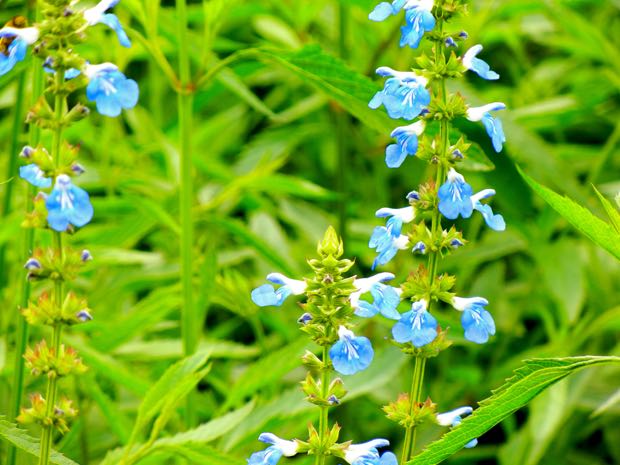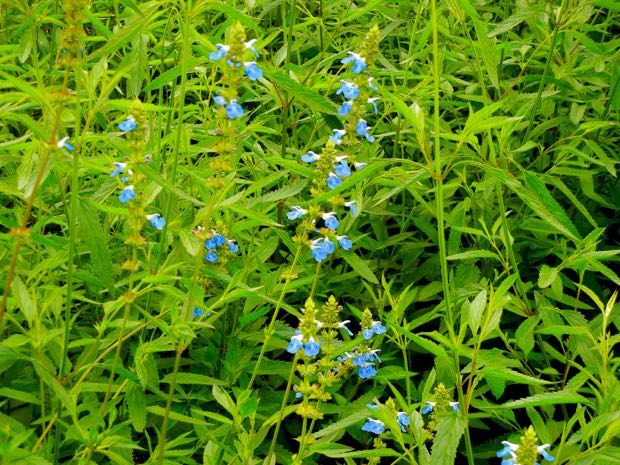Salvia uliginosa – A Stunning Perennial Delight: Bog Sage
Introduction: Salvia uliginosa, commonly known as Bog Sage, is a captivating herbaceous perennial belonging to the Lamiaceae family. Native to South America, this plant boasts graceful spikes of mesmerizing blue flowers that bloom in late summer, adding a touch of elegance to any garden. With its upright growth reaching up to 2 meters (6ft) tall, Bog Sage is a fast-growing and low-maintenance perennial that will enchant both humans and pollinators alike.
Appearance and Features: Bog Sage showcases slender, willowy stems adorned with small clusters of deep sky-blue flowers, each boasting a contrasting white throat. Its blooming period extends from late spring through fall in warm climates, and a bit later in regions with colder winters. The lance-shaped leaves exhibit a slightly sticky texture and display a yellow-green hue. This fast-spreading perennial forms an airy thicket, attracting butterflies, bees, and hummingbirds, making it a delightful addition to any garden landscape. Additionally, the cut flowers of Bog Sage can be enjoyed fresh or dried.
Cultivation of Salvia uliginosa:
Growing Salvia uliginosa is a rewarding experience, as it requires minimal care and provides a stunning display of blooms. Whether utilized in beds, borders, or as a cut flower, Bog Sage is sure to create an enchanting atmosphere. With its resistance to common diseases and pests and its preference for moist soil, this perennial is a versatile and resilient choice for both experienced gardeners and beginners.
Sunlight and Soil Requirements: Bog Sage thrives in full sun but can tolerate partial shade. It is best to provide it with at least 6 hours of direct sunlight each day to ensure optimal growth and flowering. When selecting a planting location, choose an area that receives adequate sunlight and provides well-drained soil. While Bog Sage prefers moist conditions, it can also withstand periods of drought once established. To improve soil drainage, amend heavy clay or compacted soil with organic matter, such as compost or well-rotted manure, before planting.
Watering and Fertilization: Bog Sage prefers moist soil, but it will tolerate dry conditions. Water the plant regularly during the growing season, especially during hot and dry weather, ensuring that the soil remains consistently moist but not waterlogged. To conserve moisture and reduce weed growth, apply a layer of organic mulch around the base of the plant, taking care to keep the mulch a few inches away from the stems to prevent rot. While Bog Sage does not require heavy feeding, applying a light application of a balanced organic fertilizer in the spring will help promote healthy growth and abundant flowering.
Propagation and Planting:
Salvia uliginosa can be propagated through seeds or cuttings. If starting from seeds, sow them indoors in early spring, 6-8 weeks before the last frost date. Lightly press the seeds into a well-draining seed-starting mix and keep the soil consistently moist until germination, which usually takes about 2-3 weeks. Transplant the seedlings outdoors after all danger of frost has passed, spacing them about 18-24 inches apart to allow for their spreading growth habit.
For those who prefer a quicker and more reliable method of propagation, taking stem cuttings in spring or summer is a viable option. Select healthy, non-flowering shoots and cut them just below a leaf node. Remove the lower leaves, leaving only a few sets of leaves at the top. Dip the cut end in rooting hormone to enhance the chances of successful rooting, then plant the cuttings in a well-draining potting mix. Keep the cuttings in a warm and humid environment, preferably under a clear plastic bag or in a propagator, until they develop roots. Once rooted, they can be transplanted into the garden.
Maintenance and Care:
Bog Sage is generally disease-free and low-maintenance, but some routine care will keep it thriving:
Pruning: After the flowering period, you can cut back the foliage of Bog Sage to the ground or to about 6 inches high. This helps rejuvenate the plant and encourages a fresh flush of growth in the following season.
Deadheading: Removing spent blooms regularly not only keeps the plant looking tidy but also encourages the production of more flowers. Pinch or snip off the faded flowers at the base of the stalk to prevent seed formation.
Pest Control: While Bog Sage is relatively pest-free, it can be susceptible to infestations of spider mites and aphids. Regularly inspect the plant for signs of pests and take appropriate action, such as applying insecticidal soap or neem oil, to control the infestation.
Disease Management: Bog Sage may occasionally develop anthracnose, a fungal disease that causes black spots on the leaves. If you notice any signs of anthracnose, such as black spots or lesions on the leaves, it is important to take prompt action to manage the disease. To control anthracnose, remove and destroy any infected plant material, such as affected leaves or stems. Ensure proper air circulation around the plant by providing adequate spacing and avoiding overcrowding. If necessary, apply a suitable fungicide following the manufacturer’s instructions to prevent further spread of the disease.
Winter Care: In regions with cold winters, Bog Sage may require some winter protection. As the plant dies back in late fall, cut back the stems to a few inches above the ground. Apply a layer of mulch around the base of the plant to insulate the roots and protect them from frost. This mulch layer also helps retain moisture in the soil during winter dormancy.
Potential Uses:
Salvia uliginosa, with its captivating blue flowers and tall, slender stems, offers various possibilities in garden design. It serves as an excellent choice for the back of borders or as a focal point in beds and cottage gardens. Due to its attractive blooms and ability to attract pollinators like butterflies, bees, and hummingbirds, it can be incorporated into wildlife or pollinator gardens. Additionally, the long-lasting flowers of Bog Sage make it a desirable option for cut flower arrangements, both fresh and dried.
Cautionary Notes: While Salvia uliginosa is generally considered a non-invasive plant, it is always essential to monitor its growth and prevent it from spreading beyond desired boundaries. Regular maintenance, such as division or thinning, can help control its spread and maintain a well-behaved presence in the garden. Additionally, it is worth noting that individual sensitivity to plant materials can vary, and some individuals may experience mild skin irritation when handling the foliage of Bog Sage. It is advisable to wear gloves while working with the plant, especially for individuals with sensitive skin.






